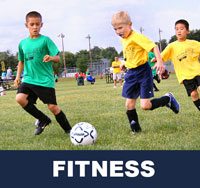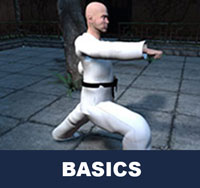Taekwondo 태권도Taekwondo Preschool
Promotion from one geup to the next can proceed rapidly in some schools, since schools often allow geup promotions every two, three, or four months. Students of geup rank learn the most basic techniques first, and then move on to more advanced techniques as they approach first dan. Many of the older and more traditional schools often take longer to allow students to test for higher ranks than newer, more contemporary schools, as they may not have the required testing intervals. View Taekwondo belt levels »

About Endurance
Sports injuries are injuries that occur in athletic activities. They can result from acute trauma, or from overuse of a particular body part. Please see a certified specialist or doctor for sports injuries. Proper guidance and instructions are needed from a certified Master Instructor ( 사범님 sabeomnim ) to ensure safe training.
Endurance (also related to sufferance and resilience) is the ability of an organism to exert itself and remain active for a long period of time, as well as its ability to resist, withstand, recover from, and have immunity to trauma, wounds, or fatigue. It is usually used in aerobic or anaerobic exercise. The definition of 'long' varies according to the type of exertion – minutes for high intensity anaerobic exercise, hours or days for low intensity aerobic exercise. Training for endurance can have a negative impact on the ability to exert strength unless an individual also undertakes resistance training to counteract this effect.
Many personnel consider endurance to be an indicator of progress, when strength and cardio training. A person is able to accomplish or withstand a higher amount of effort than their original capabilities means their endurance is increasing expressing improvement. In looking to improve ones endurance they may slowly increase the amount of repetitions or time spent, if higher repetitions are taken rapidly muscle strength improves while less endurance is gained. Increasing endurance has been proven to release endorphins resulting in a positive mind. The act of gaining endurance through physical activity has been shown to decrease anxiety, depression, and stress, or any chronic disease in total. Although a greater endurance can assist the cardiovascular system it does not imply that any cardiovascular disease can be guaranteed to improve. "The major metabolic consequences of the adaptations of muscle to endurance exercise are a slower utilization of muscle glycogen and blood glucose, a greater reliance on fat oxidation, and less lactate production during exercise of a given intensity."
The term stamina is sometimes used synonymously and interchangeably with endurance. Endurance may also refer to an ability to keep going through a tough situation involving hardship, stress, etc.
Endurance Training
Endurance training is the act of exercising to increase endurance. The term endurance training generally refers to training the aerobic system as opposed to anaerobic. The need for endurance in sports is often predicated as the need of cardiovascular and simple muscular endurance, but the issue of endurance is far more complex. Endurance can be divided into two categories including: general endurance and specific endurance. It can be shown that endurance in sport is closely tied to the execution of skill and technique. A well conditioned athlete can be defined as, the athlete who executes his or her technique consistently and effectively with the least effort.

Common methods for training include periodization, intervals, hard easy, long slow distance, and in recent years high-intensity interval training. The periodization method is very common and consists of blocks of time, generally 4–12 weeks each. The blocks are called preparation, base, build and race. The goal of a structured training program with periodization is to bring the athlete into peak fitness at the time of a big race or event.
Preparation as the name suggests lays the groundwork for heavier work to follow. For a runner contemplating a competitive marathon the preparation phase might consist of easier runs of 1–4 miles 3-4 times per week and including 2–3 days of core strengthening. In the base phase the athlete now works on building cardiovascular endurance by having several long runs staying in heart rate zone 1-2 every week and each week adding slightly more mileage (using 10% rule for safely increasing the mileage). Core strengthening is continued in the base period. Once the base phase is complete and the athlete has sufficient endurance, the build period is needed to give the athlete the ability to hold a faster pace for the race duration.
The build phase is where duration of runs is traded for intensity or heart rate zones 3-5. An easy method to obtain intensity is interval training and interval training starts to happen in the build phase. Through interval training during the build phase the athlete can achieve higher lactate threshold and in some athletes VO2 max is increased. Because interval training is demanding on the body, a professional coach should be consulted. In the very least the athlete should do a warm up and active stretching before the interval session and static stretch or yoga after hard interval sessions. It is also advisable to have days of rest or easy workouts the day after interval sessions.
Finally the race phase of the periodization approach is where the duration of the workouts decreases but intense workouts remain so as to keep the high lactate threshold that was gained in the build phase. In Ironman training, the race phase is where a long "taper" occurs of up to 4 weeks for highly trained Ironman racers. A final phase is designated transition and is a period of time, where the body is allowed to recover from the hard race effort and some maintenance endurance training is performed so the high fitness level attained in the previous periods will not be lost.

Related Articles
Physical fitness is a general state of health and well-being or specifically the ability to perform aspects of sports or occupations. It is a set of attributes or characteristics that people have or achieve that relates to the ability to perform physical activity. View Physical Fitness »
- Stretch - Form of physical exercise in which a specific muscle or tendon (or muscle group) is deliberately flexed or stretched in order to improve the muscle's felt elasticity and achieve comfortable muscle tone. The result is a feeling of increased muscle control, flexibility and range of motion.
- Flexibility - Refers to the absolute range of movement in a joint or series of joints, and length in muscles that cross the joints. Flexibility in some joints can be increased to a certain degree by exercise, with stretching a common exercise component to maintain or improve flexibility.
- Endurance - Ability of a practitioner to exert itself and remain active for a long period of time, as well as its ability to resist, withstand, recover from, and have immunity to trauma, wounds, or fatigue.
- Balance - Ability to maintain the line of gravity (vertical line from centre of mass) of a body within the base of support with minimal postural sway. Sway is the horizontal movement of the centre of gravity even when a person is standing still.
- Agility - Or nimbleness is the ability to change the body's position efficiently, and requires the integration of isolated movement skills using a combination of balance, coordination, speed, reflexes, strength, and endurance.

Taekwondo Basics
Here is where you can learn more about Taekwondo 태권도. Knowing the fundamental basics is very important for your learning path as you build your skills and knowledge. There are certain rules that need to be followed to show respect to the master ( 사범님 sabeomnim ), the instructors ( 교사님 gyosannim ), other practitioners and to the martial arts. They vary between schools but many have similar rules and guidelines. For more information View Taekwondo Basics »
Please follow the guidance of a certified Master Instructor or trainer when doing sports related activities. The article provided on this page is information that is widely available on Wikipedia articles "Muscular Endurance" and "Endurance Training". Risk of injury can be reduced by completing an effective warm up consisting of a heart raiser to get your pulse up, followed by sport specific dynamic stretches (stretches whilst moving).
There are five tenets defined in the International Taekwondo Federation (ITF) and several more in World Taekwondo (WT).
Perseverance ( 인내 in-nae ): "One will persevere time and time again until they have achieved a result which is adequate towards what one was trying to achieve." View Taekwondo Tenets »
RESOURCES
This article uses material from the Wikipedia articles "Muscular Endurance" and "Endurance Training", which is released under the Creative Commons Attribution-Share-Alike License 3.0.


























